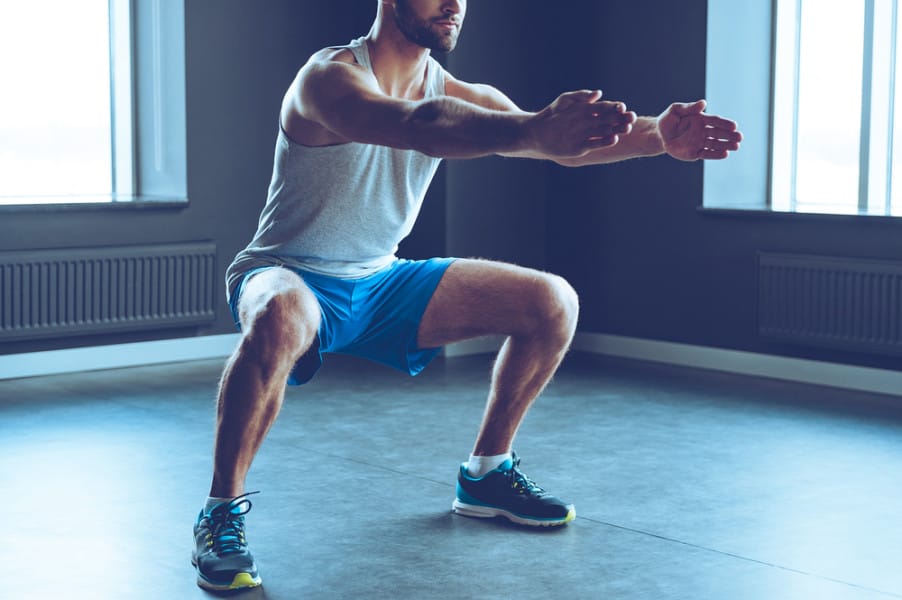Top 4 Benefits Of Squats That Go Beyond Building Lower-Body Strength
This article discusses the benefits of squats, including the muscles worked, proper technique, and variations of the squat exercise. The main benefits of squats are their ability to work multiple muscle groups, improve core strength, offer functional exercise, prevent falls, enhance athletic ability, improve bone density, and increase flexibility, and accessibility.
The primary muscles targeted by squats are the glutes, quadriceps, hamstrings, and adductor muscles, while secondary muscles include the core, back, hip flexors, and calf muscles. Squats can also be modified to be performed with or without equipment, making them a versatile exercise for individuals at different fitness levels.
The article also provides a step-by-step guide on how to do a basic squat with the correct form. Additionally, it outlines six variations of the squat exercise, ranging from beginner modifications to weighted and plyometric options. These variations include the wall squat, box squat, goblet squat, jump squat, pistol squat, and single-leg squat.
Overall, the article emphasizes the importance of squats for overall fitness development and highlights their effectiveness in targeting various muscle groups, improving core strength, and offering functional benefits for everyday activities.
- Stand a few inches away from a chair, bench, or box, with your back facing away.
- Stand in the squat position, with your feet shoulder-width apart and your toes slightly turned out.
- Bend your knees as you push your hips back into a squatting position.
- Continue lowering down until your butt touches the box (but don’t sit all the way down).
- As soon as your butt taps the box, push through your heels to return to a standing position.
- Repeat 2 to 3 sets of 10 to 12 reps.
1. Goblet squat
The goblet squat requires you to hold a kettlebell or dumbbell, which means it works your arms and the muscles in your legs more than a traditional squat. Holding the weight in front also means it kicks your core muscles into overdrive to keep you upright.
- Hold a dumbbell, kettlebell, or weighted plate with both hands at chest height.
- Stand in the squat position, with your feet shoulder-width apart and your toes slightly turned out.
- Bend your knees as you push your hips back into a squat position.
- Keep the weight in front and your trunk upright throughout the motion.
- Squat down until your hips are below your knees. (If you can’t squat this low, go as far down as you comfortably can.)
- At the end of the motion, keep your elbows inside of your knees.
- Push through your heels to stand up and return to starting position.
- Repeat 1 to 2 sets of 10 to 12 reps.
2. Back squat
A back squat requires you to hold a barbell on your shoulders for added weight.
- Place a barbell (weighted or just the bar) behind your neck resting on your shoulders. Hold the barbell at either end with your palms facing away from your body.
- Stand with your feet shoulder-width apart, shoulders back, your toes slightly turned out, and your arms at your side.
- Bend your knees as you push your hips back and shift your weight onto your heels as you squat down.
- Keep your chest up and your core tight.
- Squat down until your knees are parallel to the ground —or stop before that if you have pain or can’t maintain proper form.
- Squeeze your glutes and push through your heels to straighten your legs and return to a standing position.
- Repeat 2 to 3 sets of 1 to 15 reps.
3. Overhead squat
The overhead squat works your arms, including your deltoids and triceps, as well as your core to help balance you. It also improves your flexibility in your arms and thoracic spine.
- Stand in the squat position, with your feet shoulder-width apart and your toes pointed slightly out.
- Hold a barbell or ball over your head. (If holding a barbell, grasp it at either end with your palms facing away from your body.)
- Bend your knees as you push your hips back and shift your weight onto your heels as you squat down.
- Squat down until your knees are parallel to the ground—or stop before that if you have pain or can’t maintain proper form.
- Squeeze your glutes and push through your heels to straighten your legs and return to a standing position.
- Repeat 2 to 3 sets of 1 to 15 reps.
4. Jump squat
A jump squat is the plyometric exercise that helps improve speed and explosive strength.
- Stand with your feet shoulder-width apart, shoulders back, your toes slightly turned out and your arms held up in front.
- Bend your knees as you push your hips back and shift your weight onto your heels as you squat down.
- Keep your chest up and your core tight.
- Squat down until your knees are parallel to the ground—or stop before that if you have pain or can’t maintain proper form.
- As you reach the bottom of the squat position, push through your toes to explode up to jump in the air. Both your feet should come off the ground.
- Land softly down, letting your knees bend slightly.
- Repeat 2 to 3 sets of 10 reps.
Common form mistakes and safety tips
If you have had any recent hip or knee injuries, talk to your doctor before starting a new exercise routine. Stop any exercise that gives you pain and consider squat alternatives to strengthen your legs instead. Ensure you’re using the proper squat form, and make sure you aren’t doing any of these common squat form mistakes.
1. Watch your knees
Your knees shouldn’t cave in while performing a squat.
“Ensure your knees are aligned with your toes for the whole movement,” Peak says. “I often tell clients to imagine they are pushing their knees out to the side while squatting. This mental cue will help maintain form.”
2. Keep your chest up
Don’t let your chest fall forward while squatting. As you push your hip back for the squat, your trunk will bend forward—but keep your shoulders back and your chest up.
3. Watch your toes
Your toes should either be pointed forward or just slightly turned out during a squat. Listen to your body and place your toes in the spot that feels like the best alignment for you.
Pointing your toes further out can be done with deep squats to gain more range, however, pay close attention to your knees as this position does put extra stress on your joints. You should also make sure you are wearing the right shoes for deep squats.
4. Gradually increase the weight
When doing weighted squats, Wilking says not to start with too much weight.
“Many times we can feel discomfort because our bodies need to build a tolerance to the movement and the additional load,” she says. “This is where progressive overload is key. Slow and steady increase in weight will always win the race.”
5. Warm up properly
Before doing resistance training like squats, Peak says to do a 10- to 15-minute warm-up.
“Ensure you’ve done some basic cardio to get the blood flowing and body temperature up,” he says. “Next, you need to do some dynamic stretches to warm up the muscles and joints.”












